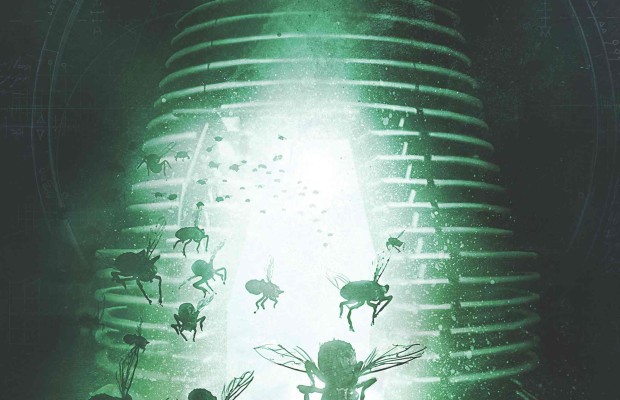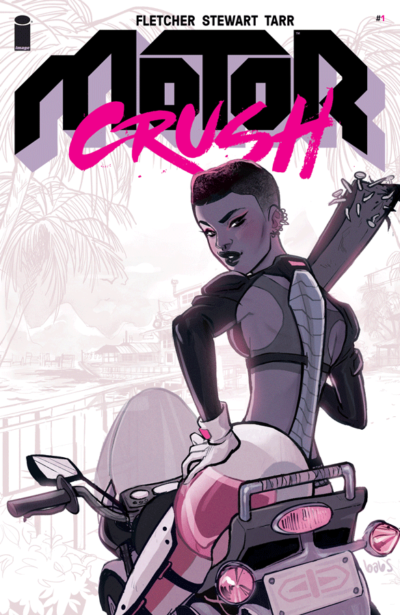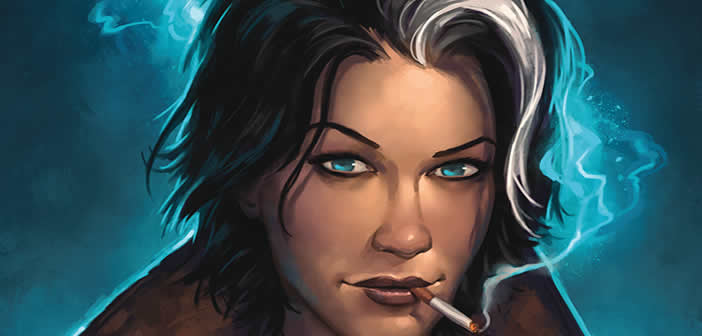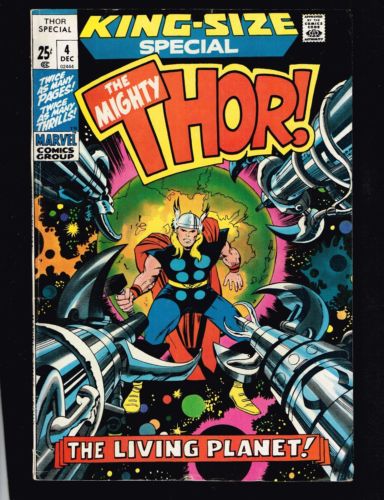David Cronenberg’s The Fly has gone down in cinematic history as a successful re-imagining of a classic ’50s science-fiction horror film. In his version, Cronenberg took the core idea of the story and added depth, personal themes, and well-defined characters, as well as heaping on loads of his signature body horror (the film would later win an Academy Award for Best Makeup) – a bit of a precursor to modern “gritty reboots,” if you will. So I think it’s pretty cool that IDW has launched The Fly: Outbreak, continuing the legacy born with the 1986 film and furthered with its 1989 sequel.
For those unfamiliar with the central concept of The Fly, it basically boils down to: (Man + Fly) x Teleportation Machine = Singular Monstrosity. This differs from the ’50s film, in which both the man and fly remain two entities, albeit with their heads switched. The franchise as a whole tends to downplay the world-shaking discovery of teleportation in favor of the horrifying potential of genetic splicing, which generally works to its benefit, though I’d like to see the former aspect explored more in the mythos, given its implications.
By the time I read the first issue, I had only seen the ’86 Cronenberg movie, as I’d heard the second was an inferior sequel. However, some elements from the comic left me confused, so I finally took the time to watch The Fly II and discovered that Outbreak connects to it pretty directly, to the point that only knowing The Fly isn’t sufficient to gain the most from the comic.
Thus, for some, a recapitulation is necessary: At The Fly II‘s start, Martin Brundle, offspring of deceased Telepod inventor/cross-species “Brundlefly” Seth, is raised in a laboratory compound run by Bartok Industries and treated like a son by CEO Anton Bartok, with the hidden intention that Martin’s condition will open new doors for research (and profit, obviously). By the film’s end, Martin has figured out a way to rid himself of his fly genes by transferring them to a second subject, via Telepod zap. This subject ends up being Anton himself, successfully turning Martin human again and deforming the CEO into a hideous, pitiful abomination.
With that covered, we have The Fly: Outbreak. Martin is now a scientific researcher at Bartok, running Telepod experiments on Anton in an effort to reform him into a human being (irony: the former lab rat experimenting on his former captor, in the same lab). Given that The Fly II would logically end somewhere in the early ’90s, coupled with the fact that characters in the comic are using iPhones and texting one another, one can infer that QUITE a bit of time has passed, with Martin perpetually running tests and Anton still living in what must be near-constant agony and primal despair. There’s even a framed photo of Anton’s former self in his cell space, which could be seen as either a sympathetic or rather cruel gesture from his handlers.
Martin is also still with Bartok employee Beth Logan (originally played by Daphne “Princess Vespa from Spaceballs” Zuniga), his love interest from the second film. Though it seems Beth wants to have kids (or, at the very least, be intimate with her partner), Martin refuses to consider it, fearing any possibility of passing unnatural genes on is too great. In the films, sex has thematic significance, leading to discovery and transformation, so it’s cool that the comic retains that in some form. However, it’s not long before Martin discovers that his most recent experiment has had an… unintended effect on Anton. I’ll leave the rest for you, should you dare to read it.
The art, done by menton3, also known as Menton J. Matthews III, is very impressionistic, with lots of dark shadows and soft lighting. Its color palette fits in with those of Cronenberg’s body horror films: dingy, icky, and muddied, though fairly muted, with bold colors used for emphasis. All in all, it serves the tense, creeping narrative well. Brandon Seifert’s dialogue is a bit quirky but generally to the point, much like the first film’s script. The events that unfold do a good job of taking the characters to new places, but I feel that the story, like The Fly II, suffers from focusing too much on the superficial details of Cronenberg’s film and not exploring the deeper aspects that made it a great story.
For reference, Seth Brundle was an extremely developed and compelling character. Jeff Goldblum’s portrayal was alternately charismatic, creepy, hilarious, profound, and tragic, which helped elevate the primary themes of Cronenberg’s story and made the movie much stronger as a whole (Seth’s motion sickness, seemingly a minor detail, was a subtle touch that lent poignancy to his pursuit of teleportation technology). Martin Brundle, because of the film’s rushed character arc and an all-around blander performance from Eric Stoltz, was not as developed, and the character is only made somewhat interesting through his circumstances. So to set him up as the central protagonist once again and to try making him interesting creates another problem to solve. But given that the comic is free of the constraints the film had, it’s entirely possible that Martin can become more defined and intriguing in the issues to come. The same goes for the rest of the cast as well.
Perhaps it’s unfair to judge Outbreak on what’s not present rather than what is, or to assume its full trajectory based off the first issue alone. But as one of many who was moved and drawn in by Cronenberg’s film, I would really like to see a continuation of the story live up to what I feel is its full potential. This does not mean to say that I’ll dismiss the comic from here on out; I’m actually looking forward to the next one, to see if the comic explores the dimensionality the film presented. Personally, I’d love to see Stathis Borans (the bitter magazine editor-turned-victim portrayed by John Getz) make an appearance, provided he lives on in this iteration’s universe. The issue itself ends with an intriguing setup for the rest of the story, which, provided good choices are made, I believe has the capacity to match the vision that has resonated with fans since 1986. In the meantime, reading this one will likely get you buzzing with anticipation…
Disclaimer: I have no material connections to the company and am reviewing it of my own accord.





